Hook-Nosed Sea Snake
Enhydrina schistosa
Sea snakes are the most numerous venomous reptiles on Earth.
Advertisement
Hook-Nosed Sea Snake Scientific Classification
- Kingdom
- Animalia
- Phylum
- Chordata
- Class
- Reptilia
- Order
- Squamata
- Family
- Serpentes
- Genus
- Enhydrina
- Scientific Name
- Enhydrina schistosa
Read our Complete Guide to Classification of Animals.
Hook-Nosed Sea Snake Conservation Status
Hook-Nosed Sea Snake Facts
- Diet
- Carnivore
- Common Name
- Hook-nosed sea snake, beaked sea snake, common sea snake, Valakadeyan sea snake
Hook-Nosed Sea Snake Physical Characteristics
- Color
- Yellow
- Blue
- White
- Light Grey
- Skin Type
- Scales
- Length
- 1,110 mm (3-4 feet)
- Venomous
- Yes
- Aggression
- High
View all of the Hook-Nosed Sea Snake images!
The hook-nosed sea snake is a highly venomous species responsible for up to 90% of fatal sea snake bites.
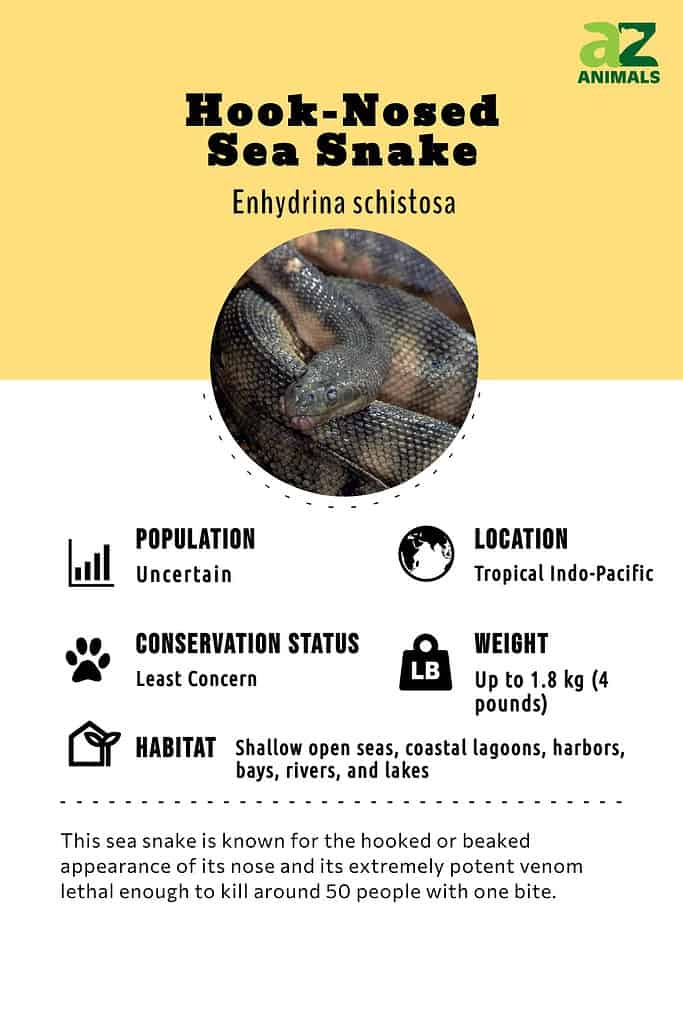
The hook-nosed sea snake — also known as the beaked, common, or Valakadeyan sea snake — is a highly venomous species responsible for half of all sea snake bites, the majority of envenomings, and 90% of fatalities. Its venom has neurotoxins and myotoxins. This is one of the most common of the 20 sea snake species in India.
5 Amazing Hook-Nosed Sea Snake Facts
- The length and shape of this species’ nose give it a beak-like or hook-like appearance.
- Its family Elapidae has snakes with neurotoxic venom, including cobras and kraits.
- Sea snakes are the most numerous venomous reptiles on Earth.
- Anyone who gets bitten by this snake needs immediate medical attention.
- It has developed glands to eliminate excess salt from their bodies due to living in saltwater.
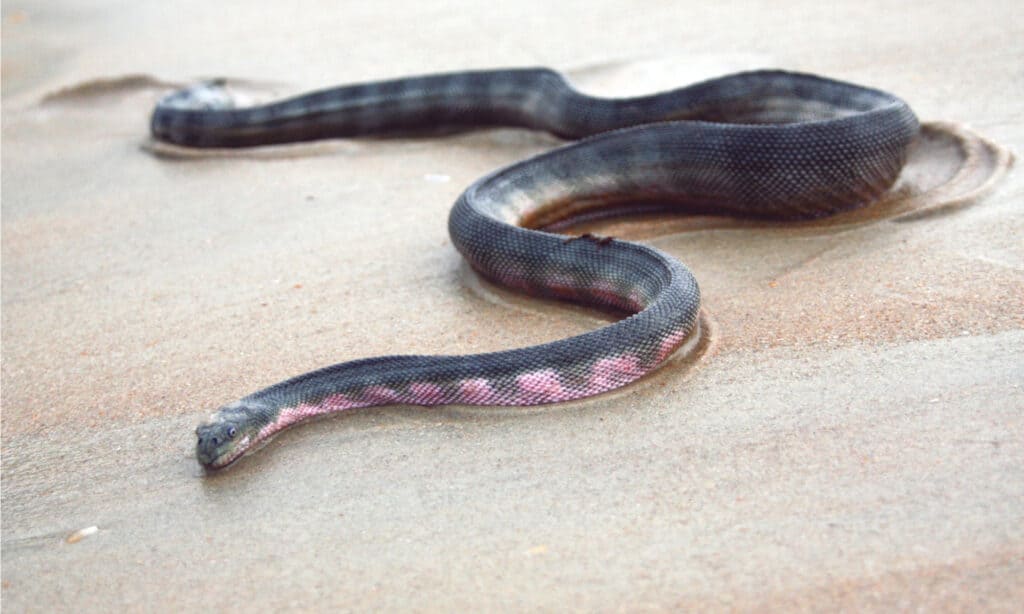
This sea snake gets its name from the hook-like or beak-like shape of its nose.
©Raimonds Romans raymoonds/Shutterstock.com
Scientific Name
The scientific name for the hook-nosed sea snake is Enhydrina schistosa. Its genus is Enhydrina, its class is Reptilia (reptiles) and its family is Elapidae, which consists of venomous tropical and subtropical sea snakes that have erect fangs. Its order is Squamata of the lizards, snakes, and scaled reptiles. It has no subspecies.
The hook-nosed sea snake is also commonly known as the Valakadeyan sea snake, referring to the Malayalam and Tamil word “Vala kadiyan,” which means “net biter.”
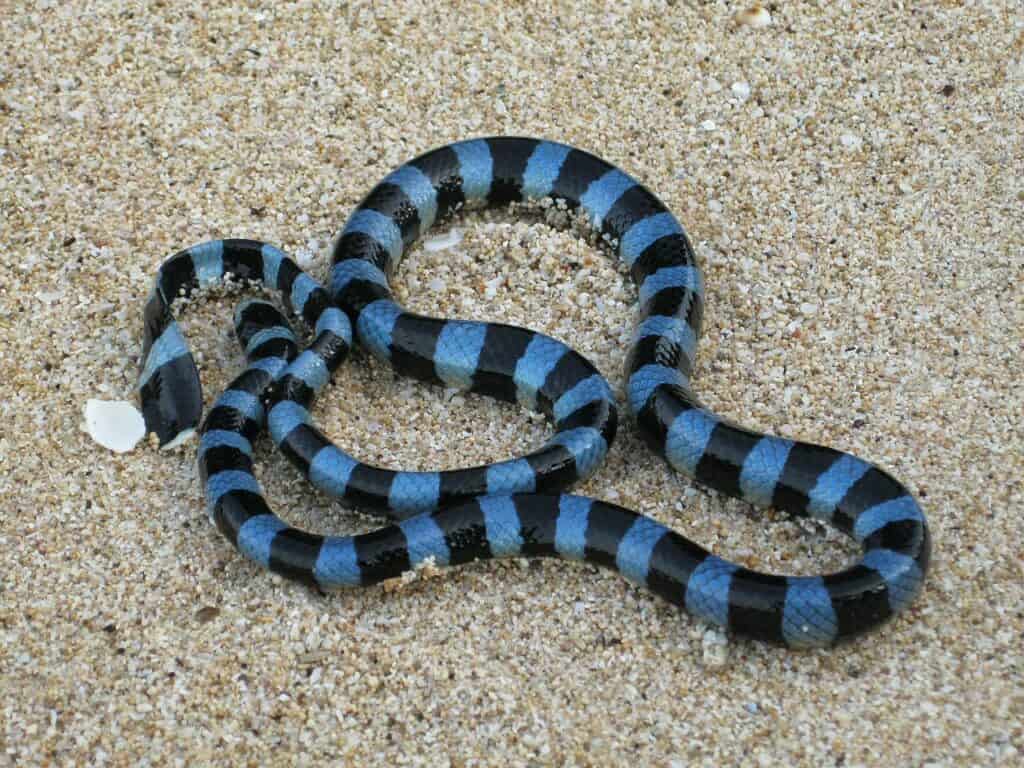
The hook-nosed sea snake belongs to the Elapidae family, of which the blue-banded sea krait is also a member.
Evolution and History
Sea snakes were first present millions of years ago and have been evolving and adapting to their aquatic habitats ever since.
The Sepik beaked sea snake (Enhydrina zweifeli) — also called the Zweifel’s beaked sea snake — was previously considered part of the hook-nosed sea snake species.
DNA testing reported in 2013 showed they were two separate species. Scientists believed convergent phenotypic evolution occurred, with the two types of snakes evolving independently in different locations but similar habitats and resulting in almost identical species. This finding was of great benefit due to the subsequent discovery that the anti-venom could be interchanged and used to treat bites from both species.
Also highly venomous, the Sepik beaked sea snake gets its name from its habitat of the Sepik River of New Guinea and is found in New Guinea and Australia. Like the other species, it lives in coastal lagoons, mangrove forests, shallow open seas, river mouths, and estuaries. Its primary food is also fish, such as catfish and pufferfish.
Hook-nosed sea snakes adapted to their aquatic environments, with a flattened, paddle-like tail helping them to swim and valve nostrils that can be shut when they dive underwater to prevent water from passing through to their lungs. Another adaptation is that they use cutaneous respiration, assisting them to diffuse the water’s oxygen through their skin into their bloodstream and emitting carbon dioxide through the skin as well. These snakes also evolved to have salt-excreting glands under their tongues that can regulate salt levels in the snakes’ bodies. In addition, they do not have expanded scales on their undersides that land-dwelling snakes do.
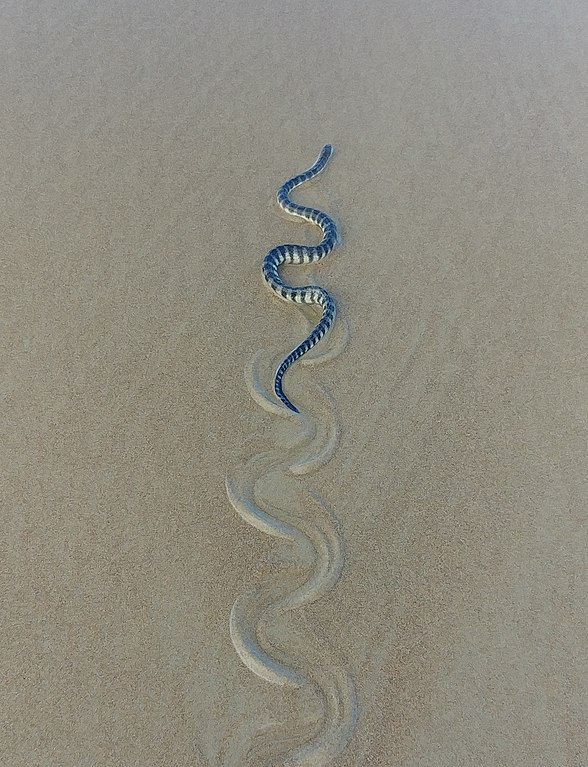
DNA testing showed that the hook-nosed sea snake and the Sepik beaked sea snake are two separate species.
©Vikramonice / CC BY-SA 4.0, via Wikimedia Commons – Original / License
Appearance
This sea snake species has as the main feature a nose that is longer than it is wide and shorter than the sides, with scales that are larger than those elsewhere on its body. The nostril scale hooks downwards over its lips.
Its color is grey on the upper half, with whitish or yellowish sides and lower half and grey-blue bars. Juveniles are olive or grey with black bands which are the widest in the middle.
On average, adult hooked-nose sea snakes measure around 91-152 cm (3-5 feet). The length of its head and body is 1, 110 mm (44 inches), while its tail, which acts like an oar to direct its movement in water, measures 190 mm (3-4 feet). It weighs up to about 1.8 kg (4 pounds).
Its coloring acts as a countershading method of camouflage, in which its dark upper sides match the shade of the ocean depths it is at, and lighter undersides help it avoid looking dark against the bright sea surface.
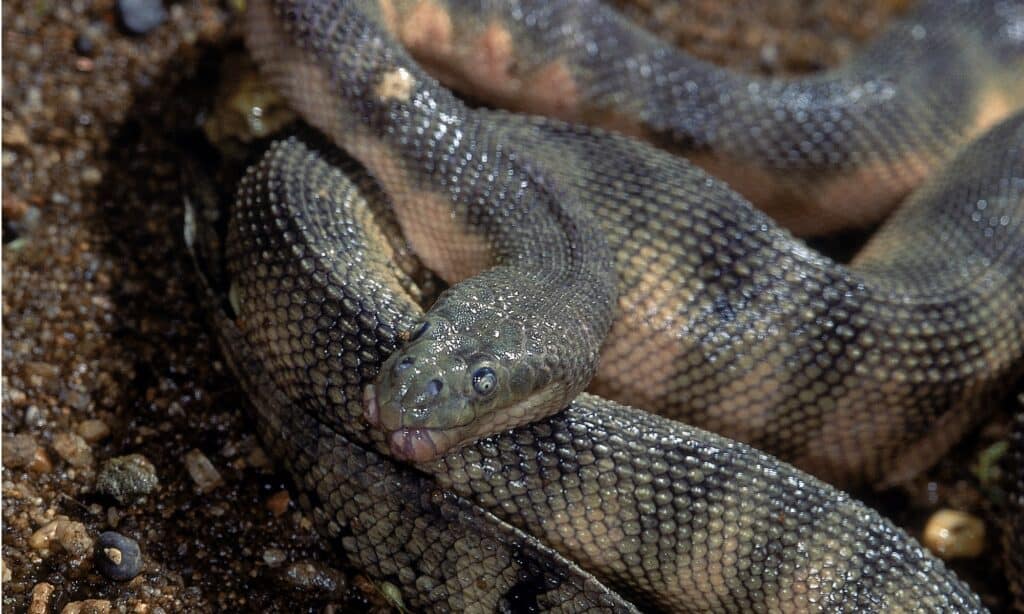
The hook-nosed sea snake’s coloring acts as camouflage, allowing it to blend in with its surroundings.
©iStock.com/ePhotocorp
How Dangerous Are Hook-Nosed Sea Snakes?
The hook-nosed sea snake is very dangerous considering how powerful its venom is. Its bite has enough venom in it to kill around 50 people. It takes only 1.5 mg of its venom to kill a human, but each bite has 7.9-9 mg. It is about twice as potent as many venomous land-dwelling snakes, and even 4-8 times more lethal than that of a cobra.
Most people are bitten while they are wading or fishing in the snakes’ muddy water habitats, where vision is poor. It’s believed that this species is responsible for about 9 out of 10 deaths from sea snake bites.
Anyone who gets bitten by a hook-nosed sea snake needs medical attention immediately, with no exceptions. There are anti-venoms available, although they are not commonly stocked in hospitals.
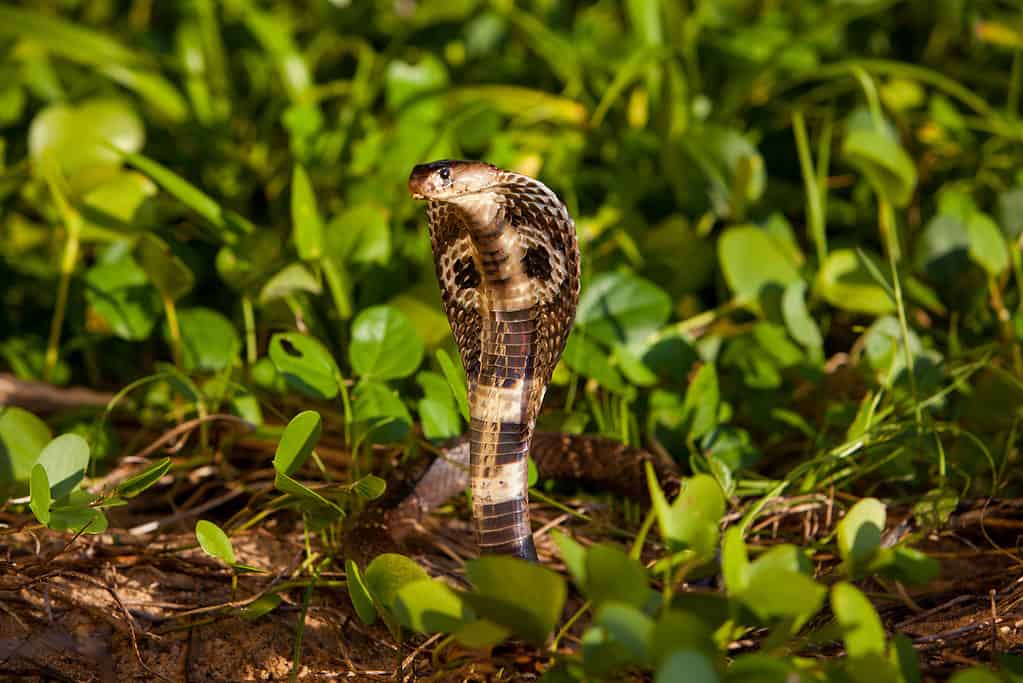
The hook-nosed sea snake’s venom is 4-8 times more powerful than that of a cobra.
©Aleksandar Kamasi/Shutterstock.com
Behavior and Reproduction
These snakes are active during the day and night and can dive up to 100 m (328 feet), but they usually remain between 0-30 m (0-98 feet deep). Although they can hold their breath underwater, their limit is five hours, and they usually do so for a half-hour to two hours at a time. They go where the current brings them.
They bite when surprised or in self-defense. They are fascinated with high-pressure hoses and other long objects.
Hook-nosed sea snakes can be aggressive, especially during the mating season, the months of which can vary depending on the population’s location. Reproduction takes place in water and these snakes give birth to 18 to 30 live young, the biggest litter of any sea snake species. Hook-nosed snakes typically live for 6-12 months in the shallows before they are prepared for life at sea. Their mortality rate is high and only a small percentage of young survive threats from predators to reach maturity at 18 months and the ability to breed by 24 months. It’s uncertain how long on average these sea snakes live in the wild.
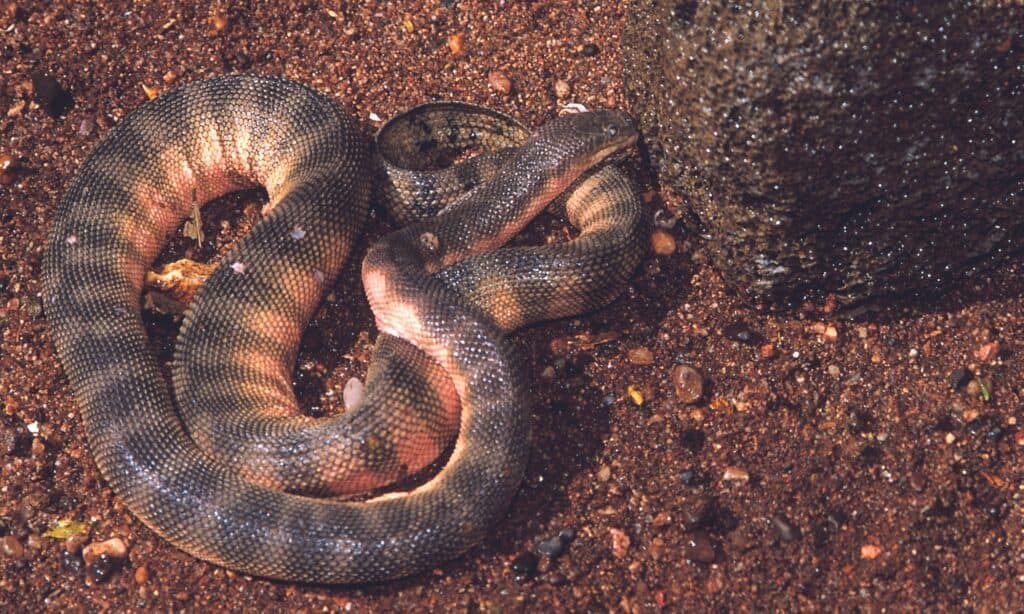
The hook-nosed sea snake usually only stays underwater for 30 minutes to 2 hours at a time.
©iStock.com/ePhotocorp
Habitat
Hook-nosed sea snakes live in shallow open seas, coastal lagoons, harbors, and shallow bays. They are present in saltwater habitats as well as in river mouths, rivers, and lakes. The ideal depth for this species is 5-30 m (16-98 feet).
The locations in which you can find hook-nosed sea snakes are the Arabia Sea, Persian Gulf, South Asia, and southeast Asia, and throughout the warm, tropical waters of the Indo–Pacific Ocean. They live on the coasts and coastal islands of United Arab Emirates (UAE), Saudi Arabia, Qatar, Oman, Kuwait, Iraq, Iran, and Bahrain, south of Madagascar and Seychelles, the Pakistani and Indian coasts from Gujarat to West Bengal, and Andaman and Nicobar Island, Sri Lanka, Bangladesh, Indonesia, Malaysia, Philippines, Singapore, Myanmar, Thailand, Vietnam, Cambodia, and China.
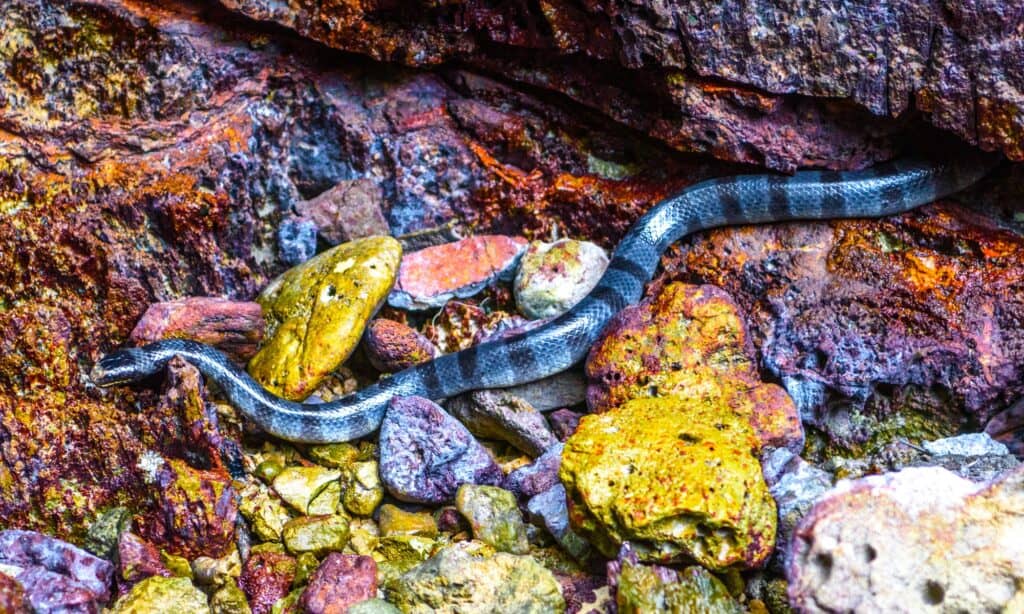
The hook-nosed sea snake makes its home in warm, tropical waters.
©iStock.com/Eagle2308
Diet
The main food sources of hook-nosed sea snakes are shrimp and catfish, which they catch usually hunting alone in shallow, murky waters and coastal waters, as well as mangrove swamps, estuaries, and rivers.
As these snakes use smell or touch to locate their prey instead of sight, they are able to hunt effectively at night. They will bite the animal to paralyze it with their powerful venom and then like other fish-eating snakes, they will swallow their meal head-first.
Predators and Threats
Fish and estuarine crocodiles prey upon baby and juvenile hook-nosed sea snakes. White bellied sea eagles were also observed hunting these snakes in a population in Maharashtra, India.
The main threats to these snakes come from humans in the form of damage to and loss of their habitats due to pollution and becoming entangled in fishing and shrimp-trawling nets (they are especially vulnerable as they hunt shrimp). They are also hunted for their meat, skin, organs, and venom, which can assist in the creation of anti-venom.
Population and Conservation Status
The population of hook-nosed sea snakes is listed as Stable according to the IUCN Red List. Its status is listed as Least Concern.
Population estimates in Malaysia were 900 to 1,400 juveniles in the Muar river estuary in 1985, while adults numbered on average 654. Juveniles grew on average 0.5gm a day because of the warm temperature of the tropical estuary. More recent population estimates are not available.
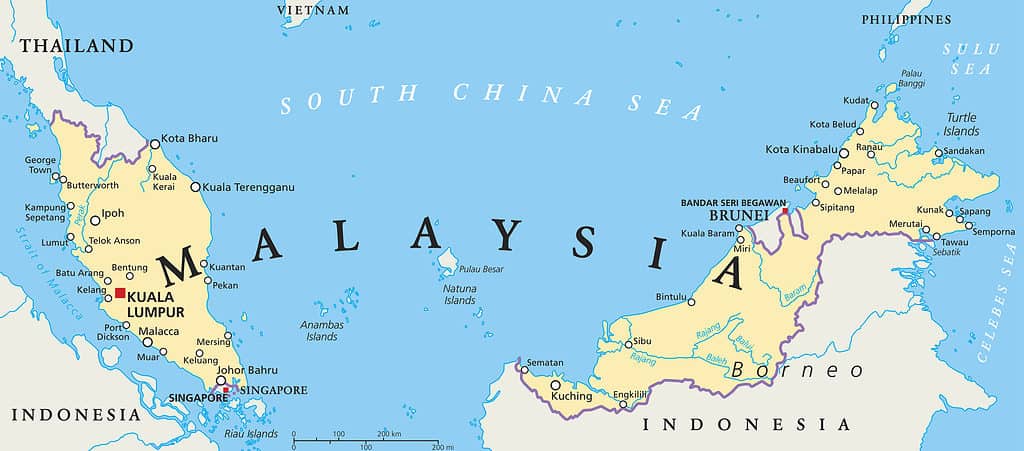
There were estimated to be 900-1,400 juvenile hook-nosed seas snakes in Malaysia in 1985.
©iStock.com/PeterHermesFurian
Hook-Nosed Sea Snake FAQs (Frequently Asked Questions)
Is the hook-nosed sea snake the most venomous snake?
Yes. It is in the top 10 of the most venomous snakes in the world, with venom that is 4-8 times more lethal than that of a cobra.
Is the hook-nosed sea snake aggressive?
Yes, this snake species is can be aggressive, especially during mating season in the winter. Otherwise, it only bites in self-defense or when surprised.
Where do hook-nosed sea snakes live?
They live in the Indian and Pacific oceans.
Is the hook-nosed sea snake poisonous?
No, it is venomous. Poisonous means it has a toxin that you ingest or inhale. Its venom is harmful when injected but most snake venom is not harmful when swallowed.
Are hooked-nosed sea snakes venomous?
Yes, they are highly venomous snakes. Its extremely potent venom is lethal enough to kill around 50 people with one bite.
How do hook-nosed sea snake hunt?
They usually hunt alone or sometimes in groups to prey on the small fish that live in coral reefs.
What do hook-nosed sea snakes eat?
Their main prey is catfish and shrimp.
Thank you for reading! Have some feedback for us? Contact the AZ Animals editorial team.
Sources
- Wikipedia / Accessed May 7, 2022
- Wikipedia / Accessed May 7, 2022
- Bioweb / Accessed May 7, 2022
- Pets on Mom / Accessed May 7, 2022
- MESA / Accessed May 7, 2022
- Ecology Asia / Accessed May 7, 2022
- Marine Life of Mumbai / Accessed May 7, 2022
- Nature Web / Accessed May 7, 2022
- Research Gate / Accessed May 7, 2022
- Roaring Earth / Accessed May 7, 2022


















